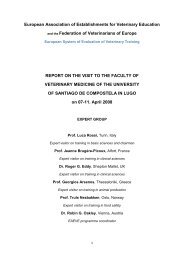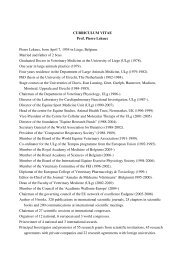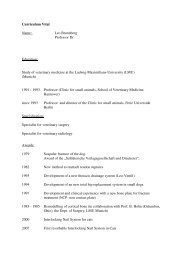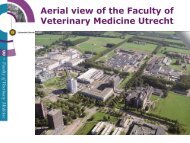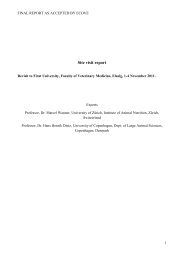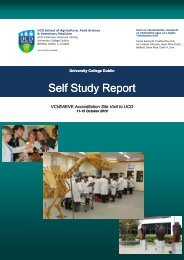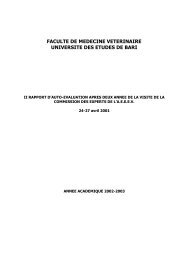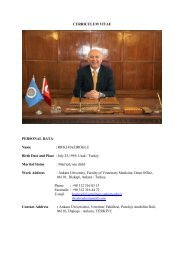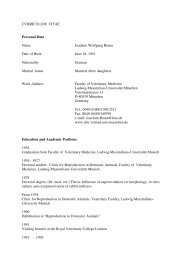Methods of Evaluation of Teachers and Curricula by Students - EAEVE
Methods of Evaluation of Teachers and Curricula by Students - EAEVE
Methods of Evaluation of Teachers and Curricula by Students - EAEVE
You also want an ePaper? Increase the reach of your titles
YUMPU automatically turns print PDFs into web optimized ePapers that Google loves.
<strong>Methods</strong> <strong>of</strong> <strong>Evaluation</strong><strong>of</strong> <strong>Teachers</strong> <strong>and</strong> <strong>Curricula</strong><strong>by</strong> <strong>Students</strong><strong>Students</strong>’ point <strong>of</strong> viewIsa Immonen, University <strong>of</strong> HelsinkiMarlies Schnierer, Vetmeduni Vienna
<strong>Methods</strong> <strong>of</strong> <strong>Evaluation</strong> <strong>of</strong> <strong>Teachers</strong><strong>and</strong> <strong>Curricula</strong> <strong>by</strong> <strong>Students</strong>• introduction:• Importance <strong>of</strong> student evaluation• legal prerequisites• negative aspects• motivation <strong>of</strong> students to evaluate• ways for students to influence• examples <strong>of</strong> teacher-/course-evaluations <strong>of</strong> Helsinki <strong>and</strong> Vienna• evaluations <strong>of</strong> curricula• examples <strong>of</strong> Helsinki <strong>and</strong> Vienna
Introduction• Why is evaluation important?• improvement <strong>of</strong> teaching <strong>and</strong> learning• possibility to plan course schedules <strong>and</strong> curriculum with the bestinterest <strong>of</strong> students in mind• co-operation <strong>and</strong> interaction between different levels within theUniversity• beneficial in providing Information to the University about thefunctionality <strong>of</strong> their programme• Student evaluations have been shown to have high validity instudies• “The student is an active <strong>and</strong> responsible participant in theacademic community.“
Introduction• Legal prerequisites for student involvement / evaluations:• <strong>EAEVE</strong>:• one student member in visiting teams• majority <strong>of</strong> student to be involved in internal quality assurance program• Helsinki:• according to the Finnish state law University board <strong>of</strong> directors has toinclude student members• the University is responsible for evaluating <strong>and</strong> enhancing teaching <strong>and</strong>learning possibilities• Vienna:• students must be included in collegial commitees <strong>by</strong> state law; Universitystatues request student involvement in almost all commitees, workgroups, ...• student course evaluations: students have a voice in quality assurance <strong>of</strong>teaching, results <strong>of</strong> student evaluations have to be considered
Introduction• Negative aspects• What can be assessed?• Can personal issues between students <strong>and</strong> teachers influence theevaluation?• <strong>Evaluation</strong> can be very subjective• poorly conducted evaluations• student motivation - some students will evaluate only ifm<strong>and</strong>atory?
Why do students evaluate?• identification with the University• awareness <strong>of</strong> importance to improve the education• improving the taught content(theoretical <strong>and</strong> practical competences)• improving the quality <strong>of</strong> teaching:• e.g.: didactical competences <strong>of</strong> teachers, motivation to learn,enthusiasm <strong>of</strong> subject transferred to students• improving the context:• e.g. social conditions, respectful teacher-student contact, moreself-confidence, …• willingness <strong>of</strong> teachers to change• willingness <strong>of</strong> the university board to change• changes for future students only
Enhancing motivation• anonymous• transparent process (for students) <strong>of</strong> what happens• easy access, no “new” technical applications• short evaluation forms, short essay questions• reminder/motivation <strong>by</strong> lecturers• voluntary vs. m<strong>and</strong>atory – legal?, incentives• results must have consequences!• communication <strong>of</strong> results & consequences to students
Ways for students to influence• Chance to influence directly or via representatives• University collegial body• Board <strong>of</strong> the Faculty• Academic <strong>and</strong> Student Affairs committee• <strong>Curricula</strong>r working group• Management team <strong>of</strong> the University Animal Hospital• Committee <strong>of</strong> Teaching Skills• Committee <strong>of</strong> Student Selection• Board <strong>of</strong> appointment for pr<strong>of</strong>essorships, habilitation committee• Student subject association <strong>of</strong> the faculty• Course/teacher/whole year/degree evaluations• <strong>EAEVE</strong>
<strong>Evaluation</strong> <strong>of</strong> teachers <strong>and</strong> coursesVienna• Competence-orientated course evaluation:• focused on learning outcomes <strong>and</strong> competence development,related to learning objectives according the curriculum• each course is evaluated• web based application, anonymous• different kinds <strong>of</strong> survey templates for different types <strong>of</strong> courses(e.g. lectures, group work, lab work, …)• in cooperation with psychologists & sociologists• questions concerning:• acquisition <strong>of</strong> pr<strong>of</strong>essional, methodical, social competence <strong>of</strong> students;• conditions <strong>of</strong> teaching & learning;• special likes/dislikes;• student’s context & his/her surrounding conditions• access to results for students
<strong>Evaluation</strong> <strong>of</strong> teachers <strong>and</strong> courses• Course evaluationHelsinki• Year 2006 - working group appointed to create a studentfeedback system• Some course evaluations before 2006 but no organised system• Main focus on learning, teaching, alignment <strong>of</strong> the courses <strong>and</strong>workload• <strong>Evaluation</strong>s collected from• Individual courses, the whole <strong>of</strong> study year <strong>and</strong> after completion <strong>of</strong> adegree.• <strong>Evaluation</strong>s <strong>of</strong> immediate impressions AND <strong>of</strong> longer timeframe• Allows the students to evaluate <strong>and</strong> compare the courses within onestudy year• Feedback forms: electronical, written, discussions• Feedback submitted anonymously/with a name
<strong>Evaluation</strong> <strong>of</strong> teachers <strong>and</strong> courses• Teacher evaluation• Rarely evaluated individuallyHelsinki• <strong>Evaluation</strong> is based on quality <strong>of</strong> teaching• <strong>Teachers</strong> are encouraged to collect evaluations <strong>of</strong> their teaching• Other• Feedback <strong>of</strong> feedback–system: A summary <strong>of</strong> student comments<strong>and</strong> evaluation, how their feedback will be taken intoconsideration in the development <strong>of</strong> teaching• Experiences <strong>of</strong> teaching <strong>and</strong> learning questionnaire (OPPI)• A m<strong>and</strong>atory part <strong>of</strong> the Bachelor’s portfolio• Filled out during first <strong>and</strong> third year• HOPS-self evaluation• Student evaluation <strong>of</strong> teachers before recruitment
<strong>Evaluation</strong> <strong>of</strong> teachers <strong>and</strong> coursesHelsinki• How are the results interpreted <strong>and</strong> used?• A network <strong>of</strong> pedagogical lecturers, one in every UH faculty• Generally results <strong>of</strong> the feedback are discussed during thedepartmental teachers’ meetings• Larger entities discussed with the disciplines concerned <strong>and</strong> inthe Academic Planning Committee• Every department has an appointed teacher for studentcounselling, quality assurance <strong>and</strong> development <strong>of</strong> teaching• Results <strong>of</strong> the whole year evaluation are published• At the same time…• <strong>Students</strong> tend to fill the forms only if they were particularlydispleased or happy with the course/teachers.• If not m<strong>and</strong>atory – response rate usually less than 50%
<strong>Evaluation</strong> <strong>of</strong> curricula• important tool <strong>of</strong> quality assurance• evaluations initiated <strong>by</strong> University• evaluations <strong>of</strong> years / tiers• evaluation <strong>of</strong> the whole curriculum• evaluations after graduation• University board / committees / student associations etc• failing / drop-out rates• <strong>EAEVE</strong>-visiting teams incl. student member
<strong>Evaluation</strong> <strong>of</strong> curricula• Why?• students’ point <strong>of</strong> view• earlier courses as preparation for later courses• vertical & horizontal integration• preparation for clinical work• workload <strong>of</strong> a certain study year• transparent procedure, visible results & consequences
<strong>Evaluation</strong> <strong>of</strong> curricula - ViennaAnalysis <strong>of</strong> students’ competences (I):• measure <strong>and</strong> monitor the transfer <strong>and</strong> acquisition <strong>of</strong> studentcompetencies• model <strong>of</strong> competences (st<strong>and</strong>ards <strong>of</strong> <strong>EAEVE</strong>, EQF, current research)• twice during students’ life:• after 3rd year;• after clinical rotations• online questionnaire• pilot in autumn/fall 2013© Evelyn Bergsmann, Petra Winter, Barbara Schober & Christine Spiel
<strong>Evaluation</strong> <strong>of</strong> curricula - ViennaAnalysis <strong>of</strong> students’ competences (II):• in cooperation with educational psychologists (University <strong>of</strong> Vienna)• students: self-analysis• teachers: taught competences• teachers <strong>of</strong> later courses• instructors: students‘ competences in “real world”• + course evaluations efficient, comprehensive concept for qualityassurance in teaching at Vetmeduni© Evelyn Bergsmann, Petra Winter, Barbara Schober & Christine Spiel
• <strong>Evaluation</strong><strong>Evaluation</strong> <strong>of</strong> curriculaHelsinki• 2003-2004 planning <strong>and</strong> trial <strong>of</strong> an organised student feedbacksystem - whole year <strong>and</strong> degree feedback• 2006 a working group for student feedback system established• Functions in the same way as course <strong>and</strong> teacher evaluations ingeneral• <strong>Evaluation</strong> <strong>of</strong> the whole study year <strong>and</strong> after completion <strong>of</strong> adegree play a key role• Focus: functionality , overlapping <strong>and</strong> workload <strong>of</strong> the curriculum• Whole study year evaluation allows students to compare courses• Crucial for curriculum planning <strong>and</strong> enhancement <strong>of</strong> functionality<strong>and</strong> teaching quality
<strong>Evaluation</strong> <strong>of</strong> curricula• Motivation <strong>and</strong> importance• Academic creditsHelsinki• M<strong>and</strong>atory in order to complete a study year / degree• Changes made because <strong>of</strong> previous evaluation results!• Other• HOPS, OPPI -self evaluation• Student attendance within University• Board <strong>of</strong> the Faculty• Collegial body• <strong>Curricula</strong>r workgroup• Committees• Subject assosiation• Direct feedback• Results in constant development <strong>and</strong> improvement <strong>of</strong> the curricula
• ”<strong>Students</strong> are in a better position than anyone else tojudge certain aspects <strong>of</strong> teaching, such as how clear,interesting, respectful, <strong>and</strong> fair a course instructor is.”• “They’re the only ones who can say how an instructor hasinfluenced their attitude toward the course subject, theirmotivation to learn it, <strong>and</strong> their self-confidence.”• “For these <strong>and</strong> other reasons, student ratings should beconsidered an essential component <strong>of</strong> faculty teachingperformance evaluation.”- FELDER RM, BRENT R



